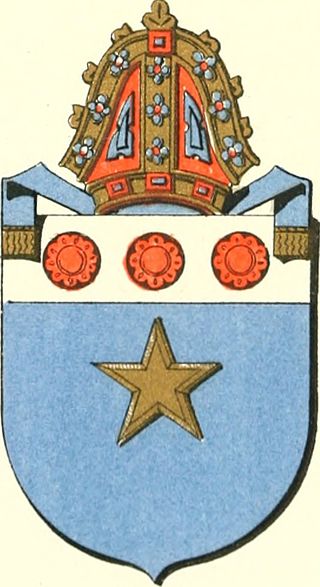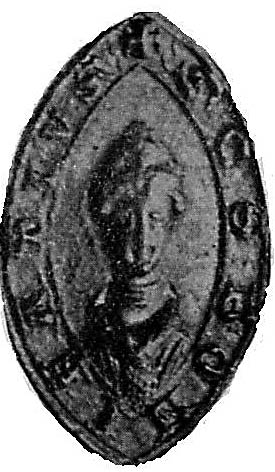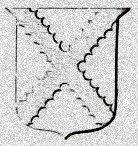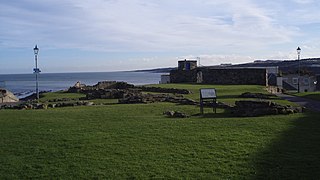Related Research Articles
Robert Crichton was a 16th-century Scottish Catholic cleric.
Ingram Lindsay [Ingeram de Lindesay], Doctor in Canon Law, was a 15th-century Scottish cleric. Despite being of illegitimate birth - one of several sons of an unmarried nobleman and an unmarried woman - he nevertheless managed in the end to pursue a successful ecclesiastical career.
Elisaeus Adougan was a late 14th century and early 15th century Scottish Catholic cleric.

Henry was a 13th-century Augustinian abbot and bishop, most notable for holding the positions of Abbot of Holyrood and Bishop of Galloway.

Gilbert was a 13th-century Cistercian monk, abbot and bishop. His first appearance in the sources occurs under the year 1233, for which year the Chronicle of Melrose reported that "Sir Gilbert, the abbot of Glenluce, resigned his office, in the chapter of Melrose; and there he made his profession". It is not clear why Gilbert really did resign the position of Abbot of Glenluce, head of Glenluce Abbey in Galloway, in order to become a mere brother at Melrose Abbey; nor is it clear for how long Gilbert had been abbot, though his latest known predecessor is attested last on 27 May 1222. After going to there, Gilbert became the Master of the Novices at Melrose.
Odo Ydonc was a 13th-century Premonstratensian prelate. The first recorded appearance of Odo was when he witnessed a charter by Donnchadh, Earl of Carrick, on 21 July 1225. In this document he is already Abbot of Dercongal, incidentally the first Abbot of Dercongal to appear on record.
Thomas de Buittle [Butil, Butill, Butyll, Butyl, Bucyl] was a Scottish prelate, clerk and papal auditor active in the late 14th and early 15th centuries. Probably originating in Galloway, Scotland, Thomas took a university career in canon law in England and France, before taking up service at the court of Avignon Pope Benedict XIII. He obtained a number of benefices in the meantime, including the position of Archdeacon of Galloway, and is the earliest known and probably first provost of the collegiate church of Maybole. The height of his career came however when the Pope provided him to the bishopric of Galloway, a position he held from 1415 until his death sometime between 1420 and 1422.

David Arnot was a Scottish prelate of the Catholic Church. He was the Bishop of Galloway (Scotland) from 1509 to 1526. He was from the Arnot family of Arnot, Fife.
Symeon is the second known Bishop of Ross in the 12th century. His predecessor Mac Bethad occurred as bishop in a document datable between 1127 and 1131.

Robert was a 13th-century prelate based in the Kingdom of Scotland. He was successively Archdeacon of Ross and Bishop of Ross; he is the second Robert to have held the bishopric of Ross.
James Hay O. Cist. was a Cistercian abbot and bishop important in the early 16th century Kingdom of Scotland. At some stage in his life he achieved a doctorate in decrees, enabling him to be styled D. D..
Thomas Hay was a 15th-century Scottish prelate. A canon of the diocese and cathedral of Aberdeen, on the translation of William Elphinstone from Bishop of Ross to Bishop of Aberdeen, Hay was provided as Elphinstone's successor in Ross, this occurring on 16 May 1483. He was probably the Thomas Hay who held the Aberdeen prebend of Turriff.
John Woodman [Wodman] was a 15th-century churchman based in the Kingdom of Scotland. Woodman was a canon of the diocese of St Andrews, and as such was locally made Prior of Pittenweem on the death of the previous prior, James Kennedy, Bishop of St Andrews; however, he was opposed by one Walter Monypenny, while the new bishop, Patrick Graham, desired the position for himself. Woodman had lost litigation for this post to Monypenny by 17 September 1466, and possession to the bishop, though Woodman was still claiming this priory as late as 1477 when he became Bishop of Ross.
Thomas Tulloch [de Tulloch] was a prelate active in the Kingdom of Scotland in the 15th century. A letter of Pope Martin V in 1429 claimed that he was "of a great noble race by both parents". Robert Keith believed that he had the surname "Urquhart", but that is not supported by the contemporary evidence and is probably spurious.
John Bullock O.S.A. was an Augustinian canon and prelate active in the 15th century Kingdom of Scotland. While earning a university degree between 1409 and 1417, Bullock gained several benefices in Scotland, and claimed the headship of St Andrews Cathedral Priory before becoming Bishop of Ross in 1418. He held the latter position until his death, which occurred in either 1439 or 1440.
Roger was a churchman based in the 14th century Kingdom of Scotland, and active as Bishop of Ross from 1325 until 1350. Before attaining this position, Roger was a canon of Abernethy; it is possible that Roger was an Augustinian, because it is often thought that Abernethy did not become a collegiate church until some time after 1328, after the marriage of the Abernethy heiress to the Earl of Angus; this however is not certain, as the exact details of Abernethy's transition from being an Céli Dé abbey to an Augustinian priory to a secular college are only vaguely understood.
Fionnlagh MacCailein or Finlay Colini was a medieval Scottish bishop. Both his early life and the details of his career as Bishop of Dunblane are not well known, however it is known that he held the latter bishopric between 1403 and his death in 1419. He was part of the circle of Robert Stewart, Duke of Albany, and was one of the many clerics from west and central Gaelic-speaking Scotland who benefited from the latter's patronage. He is said to have authorised the construction of the first bridge over the river Allan at Dunblane.

Nicholas O. Tiron, Abbot of Arbroath and Bishop of Dunblane, was a late 13th-century and early 14th-century churchman in the Kingdom of Scotland. Little is known about Nicholas until he appeared on 21 November 1299, holding the position of Abbot of Arbroath in a charter of that abbey; the last attestation of his predecessor Henry can be dated to 16 October 1296, so that Nicholas must have become abbot sometime in between these two dates.

The Church of St Mary on the Rock or St Mary's Collegiate Church, was a secular college of priests based on the seaward side of St Andrews Cathedral, St Andrews, just beyond the precinct walls. It is known by a variety of other names, such as St Mary of the Culdees, Kirkheugh and Church of St Mary of Kilrymont.
John de Crannach was a 15th-century Scottish scholar, diplomat and prelate. Originating in the north-east of Lowland Scotland, he probably came from a family associated with the burgh of Aberdeen. Like many of his relatives, he flourished in the 15th-century Scottish church. After just over a decade at the University of Paris, Crannach became a servant of the then Dauphin Charles (VII).
References
- Cowan, Ian B. & Easson, David E., Medieval Religious Houses: Scotland With an Appendix on the Houses in the Isle of Man, Second Edition, (London, 1976)
- Dowden, John, The Bishops of Scotland, ed. J. Maitland Thomson, (Glasgow, 1912)
- Keith, Robert, An Historical Catalogue of the Scottish Bishops: Down to the Year 1688, (London, 1824)
- Watt, D. E. R., Fasti Ecclesiae Scotinanae Medii Aevi ad annum 1638, 2nd Draft, (St Andrews, 1969)
- Watt, D. E. R. & Shead, N. F. (eds.), The Heads of Religious Houses in Scotland from the 12th to the 16th Centuries, The Scottish Records Society, New Series, Volume 24, (Edinburgh, 2001)